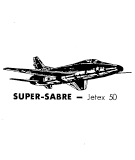 Random image Random image |
 |

F-100 SUPER SABRE
nitrocharged
|
 |
|
 |
 |
F4D SKYRAY
| F4D SKYRAY |
| Description: |
Reprinted from RAF Flying Review, Sep. 1954 , p. 51
It’s just too easy to get this all-sheet Skyray airborne. Design is ultra-stable, Jetex 50 powered, and based on authentic factory data.
Soon after the existing world air-speed record of 753.4 m.p.h. was notched up by the Douglas F4D Skyray, we decided to make a simple all-sheet replica of this unusual bat-winged aircraft. Chet Miller, Douglas public relations manager, has kindly provided 3-views, photos and other data on which to base our plans.
Previous experience with similar deltas has shown us that no dihedral was needed, an ‘S’ shaped aerofoil was best – and in this case we found that scale fin area was exactly right. The correct balance point was located by shifting the Jetex 50 backwards and forwards along the fuselage until a smooth glide resulted.
As luck would have it, the prototype had a natural turn to the right and this effectively cancelled out the left turning tendency under power – caused by the side mounted (on right) power unit. Minor trim adjustments were effected by bending the wing trailing edges and the flight pattern consisted of a steady climb curving slightly to the right, followed by tighter right circles on the glide.
Stability is as good as any conventional design and stall recovery much, much better. Glide ratio is slightly inferior to the usual wing-and-tailplane type – but the sight of a scale Skyray wheeling gracefully overhead more than makes up for this. You might expect that this would be a tricky little model to fly, but in actual fact the F4D proved to be one of those ‘naturals’ for model building just like a Piper Cub or a Fokker D-8 !
How to Build it …
Turning to the construction notes we should stress the point that wood which bends easily across the grain must be used for the wing. Start by joining three 3in. wide pieces of medium-soft 1/16 in.in. sheet, edge-to-edge – pinning down flat on the building board (see dimensioned sketch on right of plan). Trace the actual outline of the wing (A) on to these joined pieces of sheet and cut out.
Trace the fuselage (B) on to medium-hard 1/8 in. sheet and the fin (C) on to medium-soft 1/16 in. in. sheet – noting the wood grain direction. Cut out these parts, then pierce two holes in the fuselage to take the screws for the Jetex mounting clip and cement a rounded matchstick in the upper fin slot. Now trace on the markings – such as the canopy insignia, u/c doors and control surface outlines – with a soft pencil. Go over the pencil lines with a ball point pen using a straightedge as a guide where possible.
Mark the fuselage location on the wing with two soft pencil lines (top and bottom), then cement the wing in the ‘S’ shaped fuselage slot. Check that the wing squares up with the fuselage in the front view and hold the two parts together with pins until the cement dries. Cement the fin to the fuselage, making sure that it’s quite upright. Cut D from medium-hard 1/8 in. sheet and cement this to the left hand side of the fuselage – over the mounting clip holes. Now screw and cement the clip to the right hand side, so that it is parallel to the lower edge of the fuselage. Cement strips of asbestos paper to the fuselage and the wing rear of the mounting clip, to prevent those parts becoming scorched.
Cement a paper clip to the underside of the left wing panel as indicated – to counterbalance the side-mounted power unit. Push a pin into the top of the fuselage, 1/16 in. behind the first join in the wing sheets. With a loaded motor in place, the model should now balance level. If tail heavy, unscrew the mounting clip and move it forward slightly. If nose heavy, move the mounting clip back slightly. Clear doping (two coats) is optional.
How to Fly it …
Test glide from shoulder height in the usual way, bending the wing trailing edges up or down for trim adjustments. Make the model circle gently right by bending up the right trailing edge a little. Leave the fin at neutral. When you are satisfied with the glide, light the fuel igniter wick, wait for several seconds for the thrust to build up, then launch smoothly on a level keel. A shallow climb to the right should result, followed by a slightly tighter circle in the same direction after the charge is expended. Avoid flying an undoped model over wet grass as this will cause the wing to warp and spoil the trim. |
| Keywords: |
bill dean slyray f4d jetex 50 |
| Date: |
04.01.2021 00:36 |
| Hits: |
44921 |
| Downloads: |
25 |
| Rating: |
5.00 (2 Vote(s)) |
| File size: |
40.3 KB |
| Added by: |
nitrocharged |
|
|
 |
